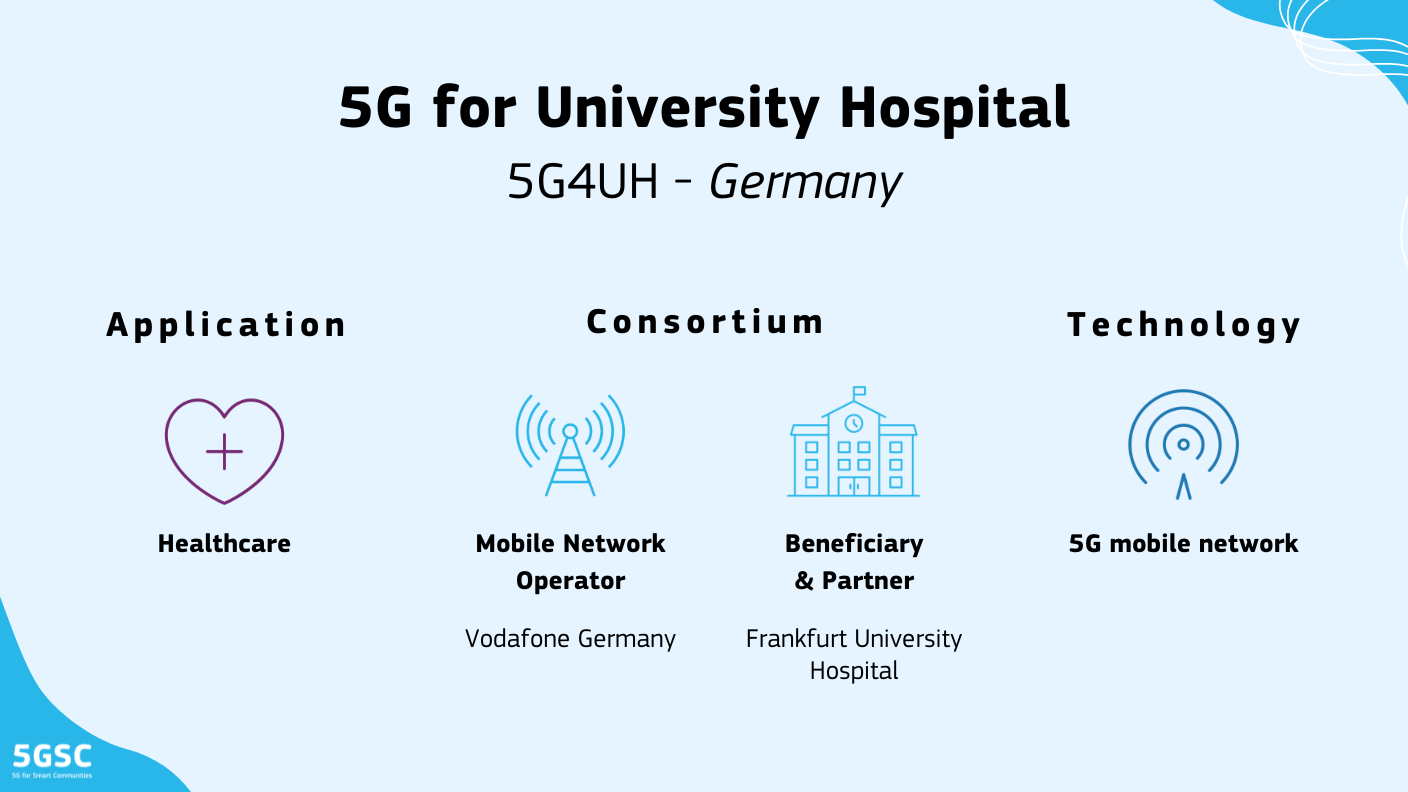

| Location | Germany – Frankfurt: Frankfurt University Hospital |
| Sector | Health |
| Network type | 5G Mobile Network |
| Project start - end date (duration) | 1 January 2023 ‑ 31 December 2025 (36 months) |
| Total budget | €4.5 million |
| EU contribution | €3.3 million |
| Lead entity / organisations | Frankfurt University Hospital: Beneficiary / Services of General Interest (SGI) provider |
| Beneficiaries and partners | Vodafone Germany: Mobile Network Operator (MNO) |
The Frankfurt University Hospital will employ a wide range of 5G-based services throughout its operations, improving the provision of public health services, and contributing to more efficient processes and a better use of resources and medical skills.
To achieve this, the project will deploy a public 5G Mobile Network in the university hospital campus in Frankfurt, Germany. This network is already designed so that it can later be put into operation as a 5G Mobile Private Network (MPN), if required by future use cases.
What will it provide?
The project will build an on‑site 5G mobile network infrastructure with high data rate and capacity, low latency, high resilience and data security, providing Frankfurt University Hospital with the technological foundation to develop and deploy innovative medical applications and optimise hospital systems, enabling better care and use of resources.
How will it work?
5G4UH will allow the development of telemedicine use cases and optimised hospital processes by using real‑time data transmission both within the hospital building as well as to remote clinics, medical specialists and emergency physicians.
Specifically, 5G4UH will implement six core use cases:
- Mobile ultrasound examinations;
- Remote COVID‑19 diagnosis;
- Digital health records;
- Optimisation of internal and external logistic processes;
- Comprehensive alarm systems;
- Wearable biosensors that allow healthcare providers to monitor patients in the hospital and at home.
More broadly, 5G4UH will enable:
- Disruption‑free teleconsultations and remote monitoring of patients, enabling ageing patients and those with chronic conditions to be reached outside of conventional clinical settings;
- Clinical Decision Support to allow better and faster decision making in situations including sepsis prevention, the hospital command centre, and rapid response teams, by using local and cloud‑based Artificial Intelligence (AI) solutions processing large amounts of data in a short time.
- Imaging and intervention control, based on systems with Augmented Reality (AR) and/or Virtual Reality (VR);
- Alarm and outage systems, in case of, for example, fire, failure of IT systems, outage of incubators or emergency rooms, by establishing a stable parallel radio structure, including mobile tablets and cell phones, in order to maintain patient care.
In addition to enabling innovative healthcare applications and services, 5G4UH’s network is also expected to:
- Improve patient care;
- Reduce the workload of staff due to a high level of digitalisation;
- Improve resource use;
- Improve competitiveness;
- Lead to the implementation of legal requirements, including the e‑Health Act, the Digital Care Act (DVG), and the Digital Care and Nursing Modernisation Act (DVPMG).
How will it be built?
The project will deploy the 5G mobile private network within building 23 of the Frankfurt University Hospital, optimised for its use cases and future daily processes.
In order to support a wide range of potential use cases, the network is designed to operate in standalone (SA) and non-standalone (NSA) modes, as well as ensuring redundancy. To enable this, it will use spectrum ranging from LTE 1800 and LTE 2100 to 3500 MHz 5G New Radio (NR).
To simplify the implementation of in‑house coverage, three frequencies will be transmitted via one access point, as well as using a private connection to link with the core switch in Frankfurt.
The on‑site 5G network infrastructure will provide:
- Downlink speed of 1 Gbps and uplink speed of 300 Mbps;
- Peak data throughput of 1 Gbps at NR 3500, and medium data throughput of 200 Mbps at 700 MHz and 1 Gbps at 3500 MHz (NR);
- Latency of 25‑35ms (NSA);
- Fibre optic connection with local area network (LAN) cabling on floor level;
- Redundancy (NSA) of three poles with fibre optics as well as directional radio (260 Mbps) for redundancy;
- Enhanced mobile broadband (eMBB), as well as massive machine‑type communications (mMTC) and ultra‑reliable low‑latency communications (uRLLC) with LTE 3500 NR.
How is it financed?
The 5G4UH project has a total budget of €4.5 million, of which €3.3 million under the Connecting Europe Facility (CEF) Digital programme.
Who is involved?
The 5G4UH project is run by a multidisciplinary consortium, including:
- Vodafone Germany: Mobile Network Operator (MNO)
- The Frankfurt University Hospital: offering the Services of General Interest (SGI)
How can I find out more about the project?
The European Health and Digital Executive Agency (HaDEA)
Contact HaDEA
Read more:
- Presentation
- Frankfurt University Hospital press release 1, press release 2
- Vodafone Germany press release
Related websites and social media:
